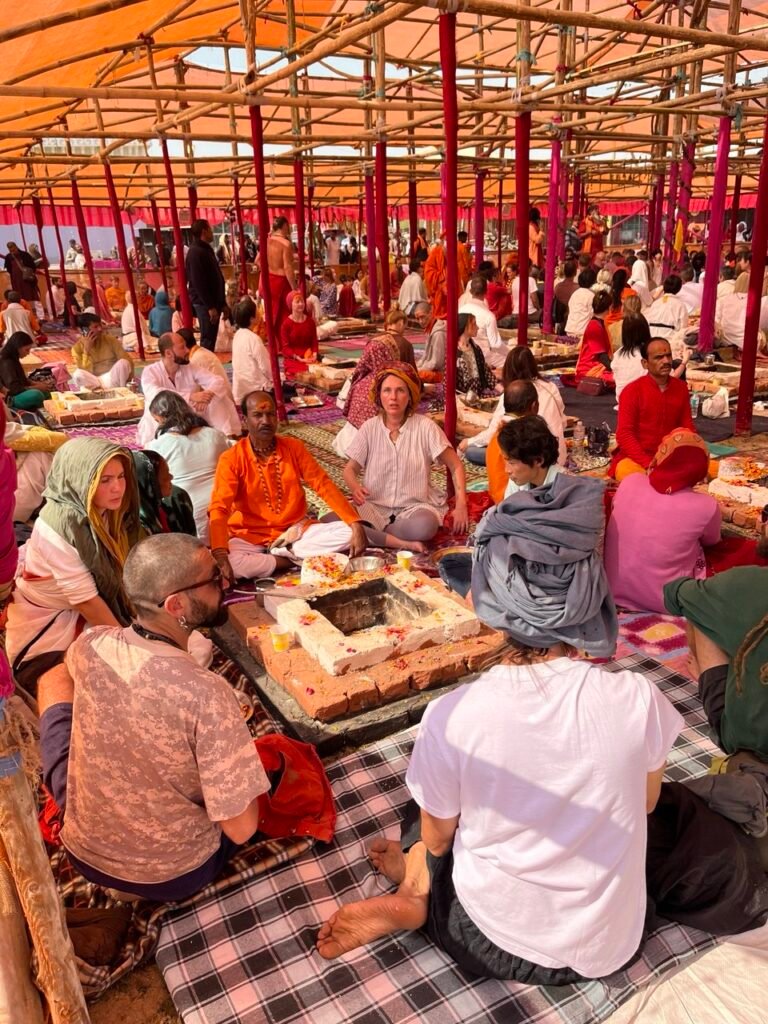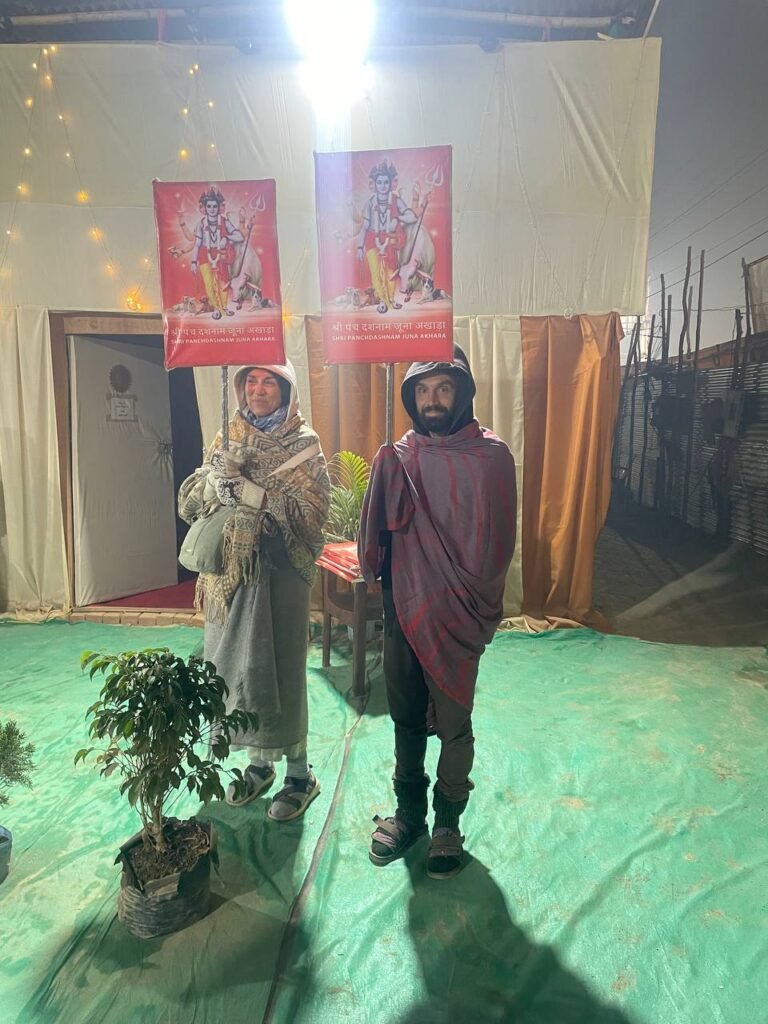If you’re new to the Maha Kumbh Mela, you may want to start with my earlier posts:
Madness or Faith? A Pilgrimage to the Maha Kumbh Mela explores the initial plunge into the spiritual chaos.
Morning in Allahabad
The next morning, after a leisurely Indian-style breakfast — with mango lassi and various kinds of paneer (a fresh cheese prepared in dozens of delicious variations) — Kirill and I went to explore local pharmacies in search of a small neti pot for nasal rinsing.

Each new day spent in the dusty Indian reality became more physically noticeable for our friend. Along the way, we tried some pomegranate juice that was, for some reason, pink in color. After resolving our practical needs, we returned to the camp to join our friends.
Festival Atmosphere: Ascetics, Gurus, and the Crowd
We missed the rituals that Nastya and Mykola had planned to attend before the famous bathing due to a lack of communication and the fact that a different scenario was unfolding for us. The camp was fascinating—thousands of strange characters filled its space.


In addition to the now-familiar crowds of pilgrims, there were countless sadhus (ascetics) in orange robes, nagas (more radical ascetics), often naked and covered in ash, and extreme aghori ascetics. We would later get to know them more closely in Varanasi, where life and death are deeply intertwined.
Gurus in Sunglasses and the Energy of the Gaze
Various Indian gurus with thousands of followers and babas (a broad term, but in our context — spiritual leaders or holy men) — often of very unusual appearance and ambiguous reputation — moved through the crowd. Some drove through the pilgrims with security in cars, while others sat in tents.
Their staple accessory was sunglasses, which created a somewhat paradoxical image. When I asked Kirill, my temporary Wikipedia on India’s spiritual life, what the meaning of this carnival was, he gave a rational answer: not everyone can withstand their gaze and the energy that emanates from them.
On many questions during those days, Kirill answered that satisfied my mind, skilfully providing logical explanations—something I needed to understand better the seemingly illogical (or, perhaps, just unknown) aspects of Hindu beliefs.
The Crowd as Reality
That day, we encountered a true crowd for the first time — not just a dense stream of people, but a mass so thick that it was impossible to pass through. At the intersections of the tent city, we had to hold hands so as not to get lost forever in the crowd.
It’s worth noting the way Indian pilgrims move in groups. Crossing such a stream was nearly impossible. We encountered dozens of people tightly holding hands, sometimes gripping a rope as they moved together, forming an unbreakable human chain. So, we also began holding hands—almost like children—but it was simply a matter of survival in extreme conditions.

That habit stayed with us even after leaving the Maha Kumbh Mela and probably looked strange to outsiders, giving rise to all sorts of misconceptions far from the actual situation. But we were in India, where everything is perceived differently. Indians are very open and tolerant toward diverse life forms and beliefs. Behind this outer acceptance lies a complex and multilayered reality.
Hijras — Sacred and Marginalized
Take, for example, the caste of the untouchables — Hijra — a caste that includes transgender people, eunuchs, and intersex individuals. I may be going off-topic here, but it all points to the same thing — the incredible diversity of India, which was fully embodied in the Maha Kumbh Mela. But let’s fill in this parenthesis.
Among India’s many unique social groups, the hijra holds a special place. Their history goes back centuries, intertwined with myths, religious traditions, and social changes. The hijra lives outside the conventional male/female binary: intersex individuals, transgender women, and castrated men — people both revered and rejected by Indian society.
For ages, they have been seen as carriers of extraordinary spiritual power. Their blessings at weddings and childbirth are still considered to bring good luck. Nevertheless, their existence is often on the edge of social isolation. Only in 2014 did India’s Supreme Court officially recognize them as a third gender — but even this step could not erase centuries of prejudice overnight.
Photographer Muhammed Muheisen captured the life of the hijra in his work, showing not only their struggle for recognition but also their daily reality—full of contrast. His images reveal faces filled with dignity, suffering, and hope—a reflection of the hijra’s dual nature, constantly balancing sacred reverence and social stigma.
An Island of Silence: Paramahansa Yogananda’s Pavilion
But it’s time to return to the dusty expanses of the Maha Kumbh Mela, where we spent quite a while trying to reconnect with our friends. And then, amidst the endless chaos of pilgrims and ascetics, we suddenly found ourselves in front of the pavilion of the Yogoda Satsanga Society, founded by Paramahansa Yogananda.
Until that moment, I had known nothing about him or his teachings, and perhaps that’s why the contrast between the noisy, roaring river of the festival and this place struck me so profoundly. Unlike me, Kirill was, of course, already familiar with them and gently catapulted me into a completely different space.
There was silence—not forced but natural, as if the air was calm. The people looked different. Their eyes were serene, their movements balanced. It was as if they had found something I had yet to discover.
This pavilion became an island of detachment in the whirlwind of passion, asceticism, and ritual ecstasy. For the first time, I felt that spiritual searching was possible in the fire of severe practices and the soft light of inner balance.
Paramahansa Yogananda founded the Self-Realization Fellowship (SRF) in 1920 in the USA. In India, this organization is known as the Yogoda Satsanga Society of India (YSS), which he established in 1917.
This spiritual school focuses on spreading the teachings of Kriya Yoga, combining ancient Indian wisdom and practices with the modern spiritual quest. Yogananda aimed to convey the unity of all religions and the importance of personal experience of God through meditation. His book Autobiography of a Yogi became one of the most well-known spiritual works of the 20th century. It was also Steve Jobs’s favorite book.
After visiting the pavilion, we both decided to return to the city, enjoy a good dinner, and sort out the upcoming night’s bathing issue.
Missed the beginning of the journey?
• Part 1 – Madness or Faith? A Pilgrimage to the Maha Kumbh Mela
• Part 3 – To Be or Not to Be: On the Eve of the Great Bathing
🌍 India Travel & Spiritual Journey Series
- The Word Was with God – How India Found Me
A personal and spiritual awakening begins in India’s heartland. - Delhi Shock – My First Night in India
Raw impressions from the chaotic, vibrant capital. - The Divine Heart of India – Vrindavan, Krishna, and Rama
A deep dive into sacred cities and mythic lore. - Madness or Faith? A Pilgrimage to Maha Kumbh Mela
Encountering the world’s largest religious gathering. - Exploring Hinduism’s Greatest Festival – Maha Kumbh Mela 2025
A guide and reflection on faith, crowds, and ritual. - To Be or Not to Be: On the Eve of the Great Bathing
Facing existential questions on the threshold of the sacred. - Where the Fires Burn – First Encounters with Varanasi
A visceral arrival in India’s most mystical city. - Between Life and Flame – Tales from the Ganges
Reflections on death, devotion, and the river’s eternal flame. - Journey Through Varanasi – Saturn, Sound, and Spirit
Myths, music, and meaning in India’s spiritual capital. - Puttaparthi: A Dream Made Real
A village transformed by faith: the story of Sathya Sai Baba’s birthplace. - At the Edge of the Universe – A Journey Through Puttaparthi
A cosmic path of devotion, silence, and the soul’s unfolding.
